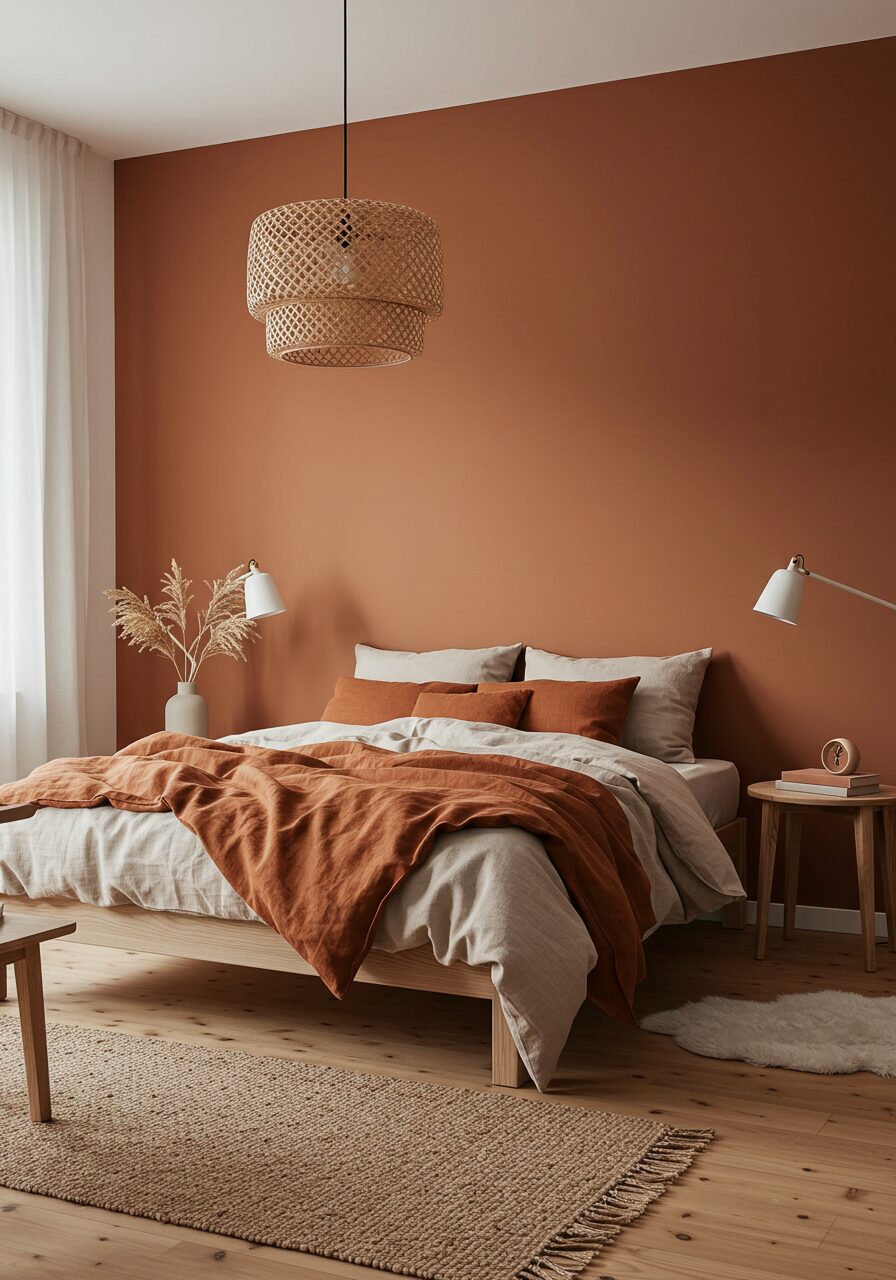Scandinavian design has captured hearts worldwide with its perfect balance of minimalism, warmth, and functionality.
These Nordic-inspired bedrooms prove that less truly is more, creating spaces that feel both serene and inviting.
From the iconic white walls to natural wood textures, Scandinavian bedrooms embrace simplicity without sacrificing comfort.
The philosophy centers around creating cozy, lived-in spaces that promote rest and relaxation.
Scandinavian Bedroom Ideas
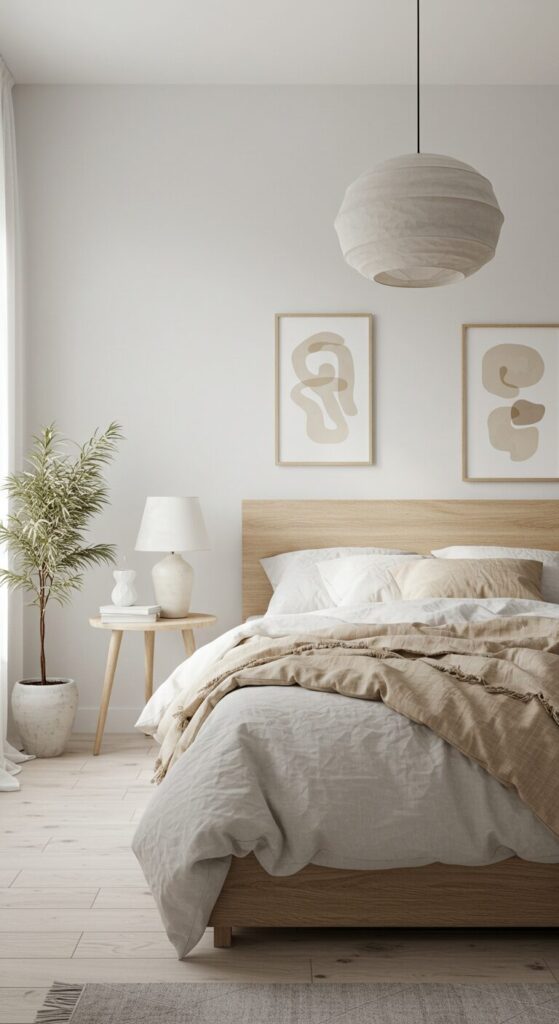

Whether you’re drawn to the classic hygge aesthetic or modern Nordic minimalism, these 18 ideas will transform your bedroom into a Scandinavian sanctuary that feels effortlessly stylish and genuinely peaceful.
1. Classic White and Wood Minimalist Retreat
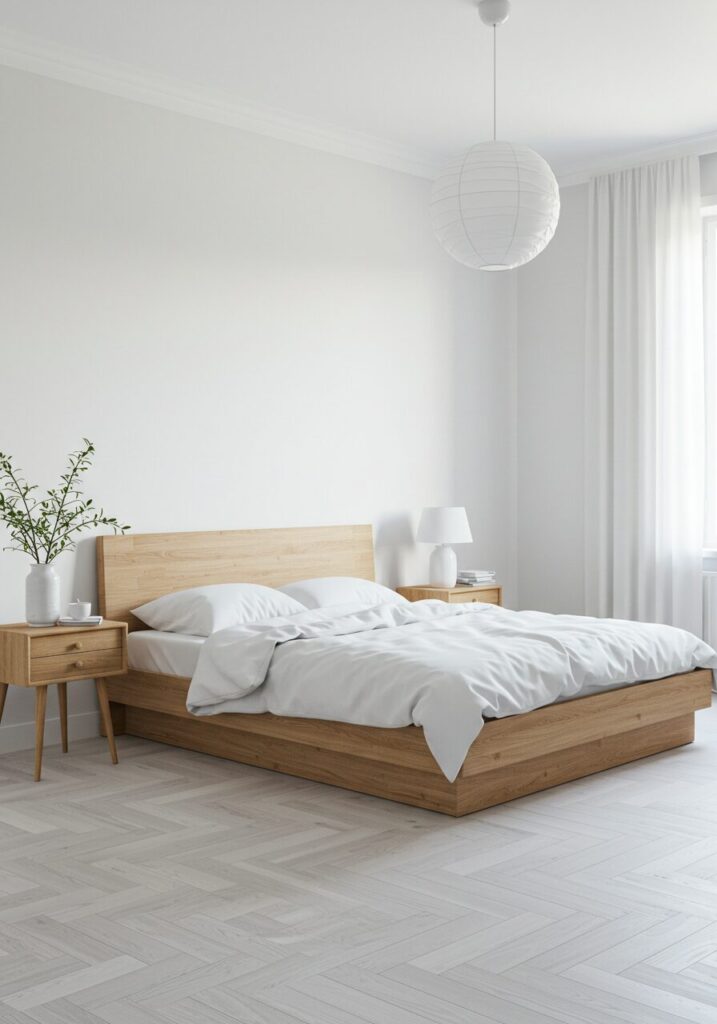
The foundation of Scandinavian design lies in crisp white walls paired with natural wood elements. This timeless combination creates an airy, peaceful atmosphere that never goes out of style.
Light oak or birch furniture against snow-white walls instantly brightens any space. The contrast adds visual interest while maintaining the clean, uncluttered aesthetic Scandinavian design is famous for.
I’ve found that adding different wood tones—like a walnut nightstand with pine flooring—creates subtle depth without overwhelming the minimalist foundation.
2. Cozy Hygge Haven with Layered Textures
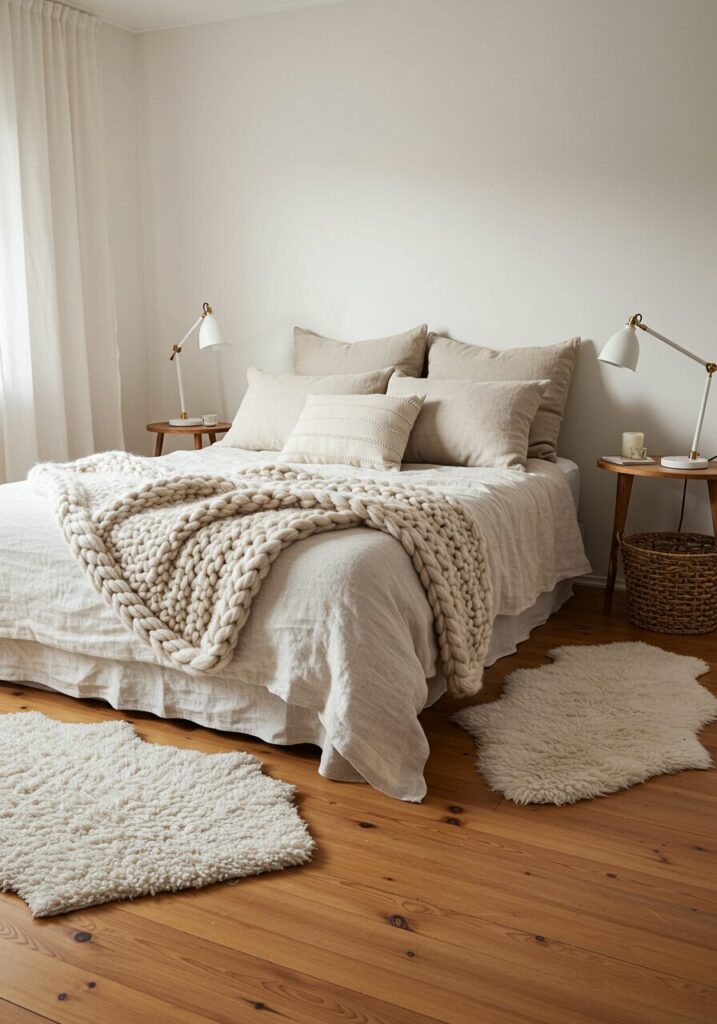
Hygge represents the Danish art of coziness, transforming bedrooms into warm retreats through carefully layered textures. Think chunky knit throws, sheepskin rugs, and linen bedding in neutral tones.
Multiple texture layers create visual and tactile interest without adding color or clutter. This approach makes the space feel inviting and lived-in rather than stark or cold.
The key to successful texture layering is varying the scale—pair fine linen sheets with a chunky wool throw and a smooth ceramic lamp base.
3. Sage Green Scandinavian Sanctuary

Muted sage green walls create a calming, nature-inspired bedroom that feels both modern and timeless. This soft green hue pairs beautifully with natural wood and white accents.
The earthy tone brings a sense of tranquility while maintaining the clean lines characteristic of Scandinavian design. It’s sophisticated enough for adults yet soothing enough for restful sleep.
Sage green works particularly well in bedrooms with limited natural light, as it adds color without feeling heavy or overwhelming.
4. Dusty Rose Nordic Romance
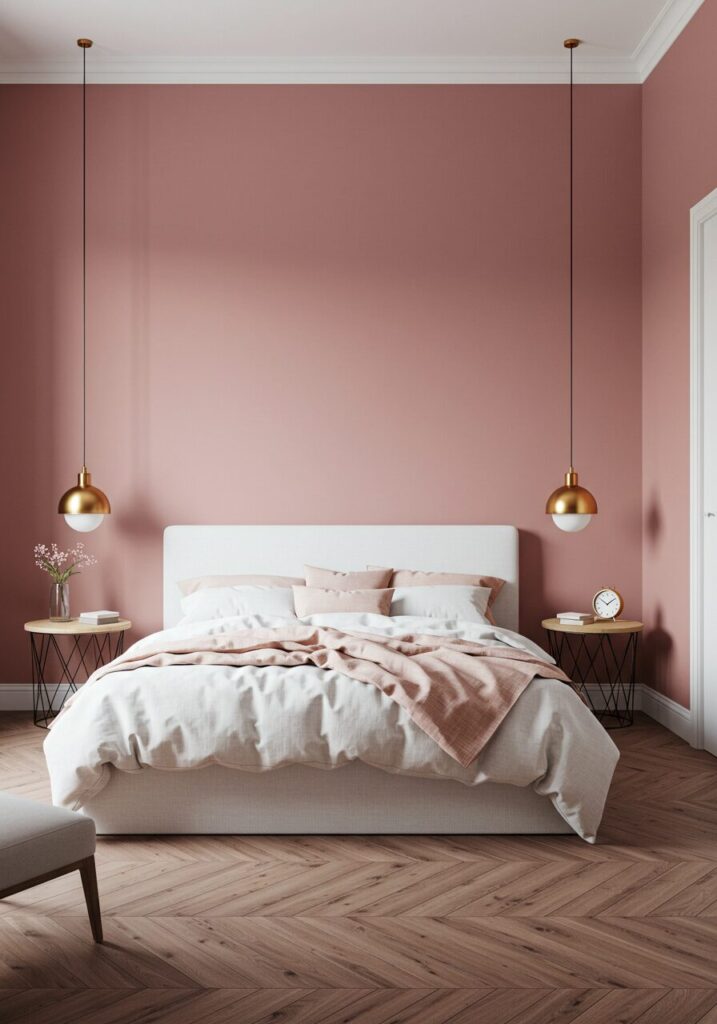
Soft dusty rose walls bring warmth and femininity to Scandinavian bedrooms while maintaining the style’s signature sophistication. This muted pink tone creates a romantic yet modern atmosphere.
The gentle color works beautifully with brass fixtures and warm wood tones. It’s subtle enough to feel mature while adding personality to the typically neutral Scandinavian palette.
Dusty rose is incredibly versatile—it complements both cool and warm wood tones, making it perfect for existing furniture pieces.
5. Charcoal Gray Modern Minimalism
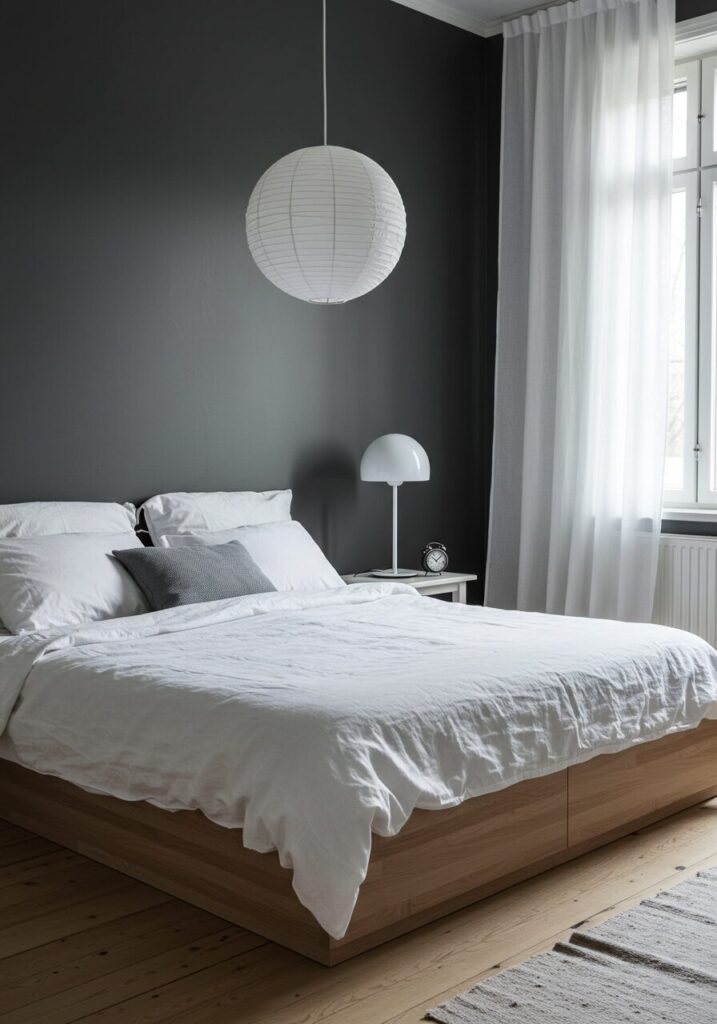
Deep charcoal gray walls create a dramatic backdrop for modern Scandinavian bedrooms. This bold choice adds sophistication while maintaining the clean, uncluttered aesthetic.
The dark color makes white bedding and light wood furniture pop dramatically. It’s perfect for creating a cocoon-like feeling that promotes deep, restful sleep.
Charcoal gray works exceptionally well in bedrooms with excellent natural light, as it absorbs light beautifully without feeling oppressive.
6. Navy Blue Scandinavian Elegance
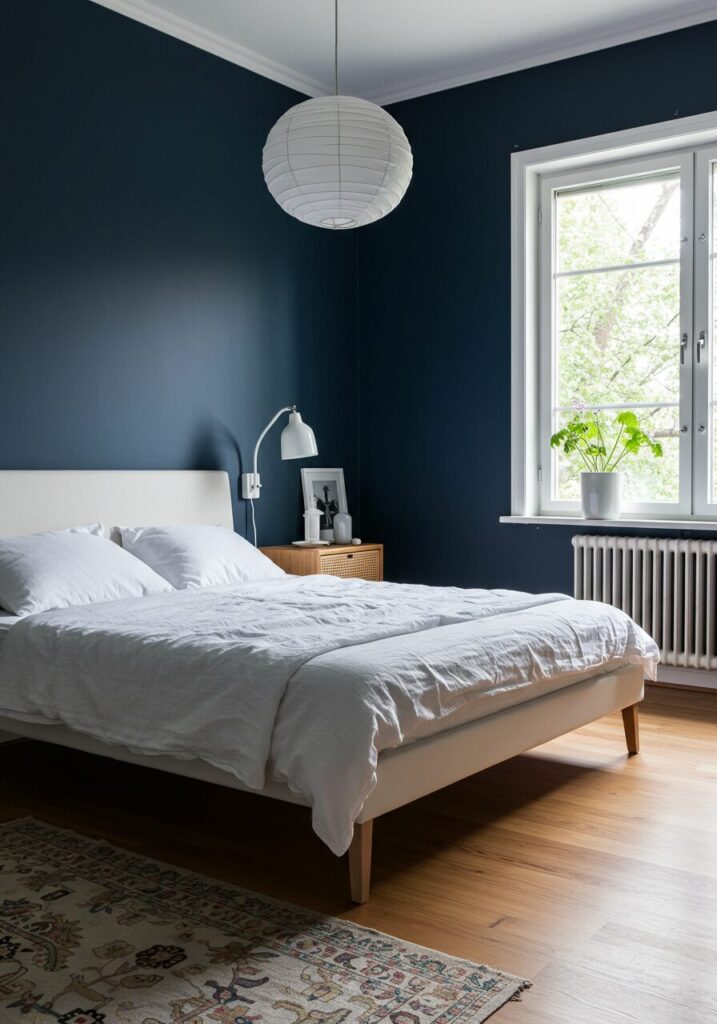
Rich navy blue walls transform bedrooms into elegant, sophisticated retreats. This deep color adds drama while maintaining the calming qualities essential to Scandinavian design.
Navy creates a perfect backdrop for white linens and natural wood furniture. The color is timeless and works beautifully with both warm and cool lighting.
Navy blue is incredibly forgiving with different lighting conditions, looking equally stunning in morning sunlight and evening lamplight.
7. Warm Terracotta Scandinavian Comfort
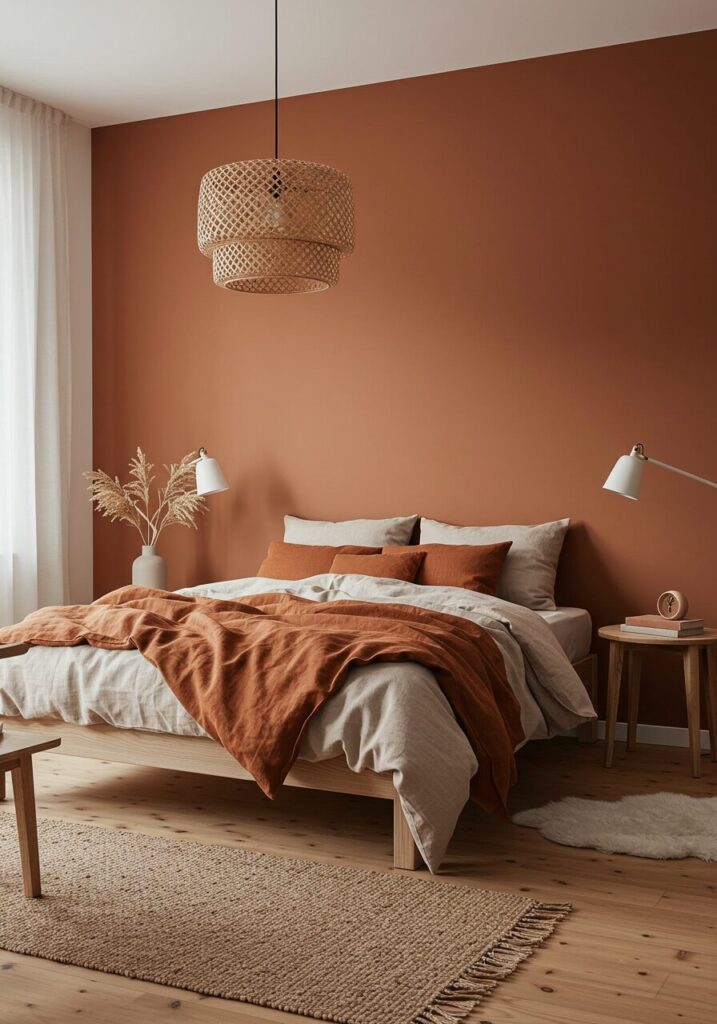
Earthy terracotta walls bring warmth and personality to Scandinavian bedrooms. This rich, clay-inspired color creates a cozy atmosphere while maintaining clean, modern lines.
The warm tone complements natural materials beautifully, from jute rugs to wooden furniture. It’s grounding and peaceful, perfect for creating a restful sanctuary.
Terracotta works wonderfully in bedrooms with cooler natural light, as it adds warmth without requiring additional heating elements.
8. Soft Lavender Scandinavian Serenity
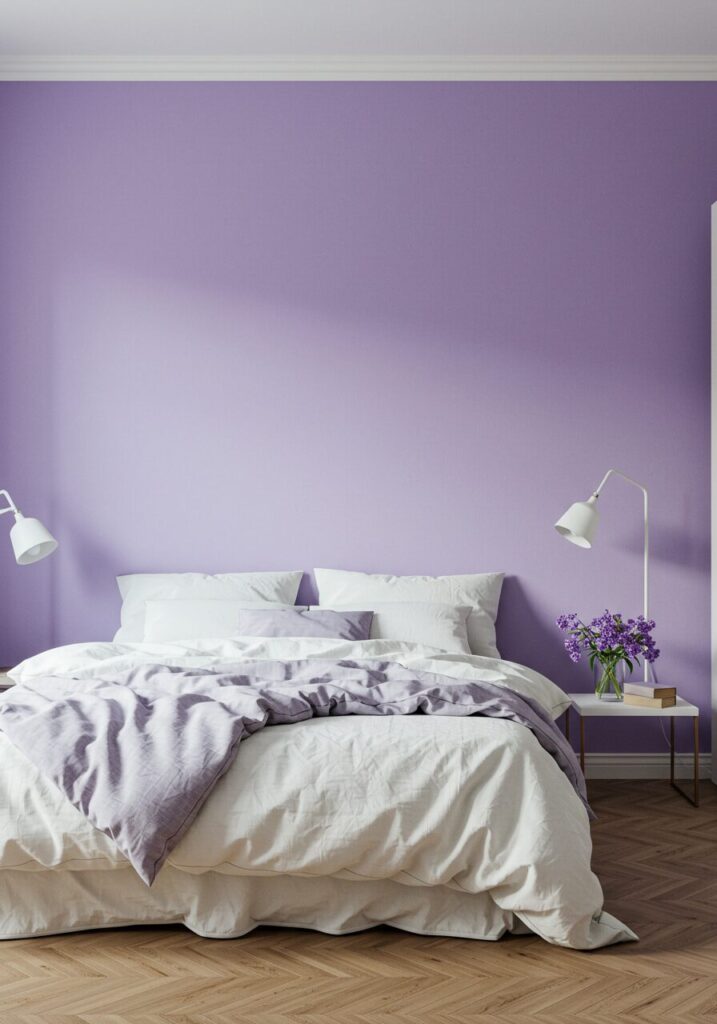
Gentle lavender walls create a serene, spa-like atmosphere perfect for relaxation. This soft purple hue adds color while maintaining the peaceful qualities of Scandinavian design.
The subtle color promotes calm and tranquility, making it ideal for bedrooms. It pairs beautifully with white linens and natural wood elements.
Lavender is scientifically proven to promote better sleep, making it both beautiful and functional for bedroom spaces.
9. Cream and Linen Scandinavian Warmth

Warm cream walls create a cozy, envelope-like feeling in Scandinavian bedrooms. This neutral tone adds warmth without overwhelming the space’s minimalist aesthetic.
Cream works beautifully with natural linen textures and warm wood tones. It’s sophisticated and timeless, creating a bedroom that feels both modern and comfortable.
Cream is incredibly versatile and works well with both silver and brass hardware, making it perfect for mixing metals in your space.
10. Soft Blue Scandinavian Tranquility
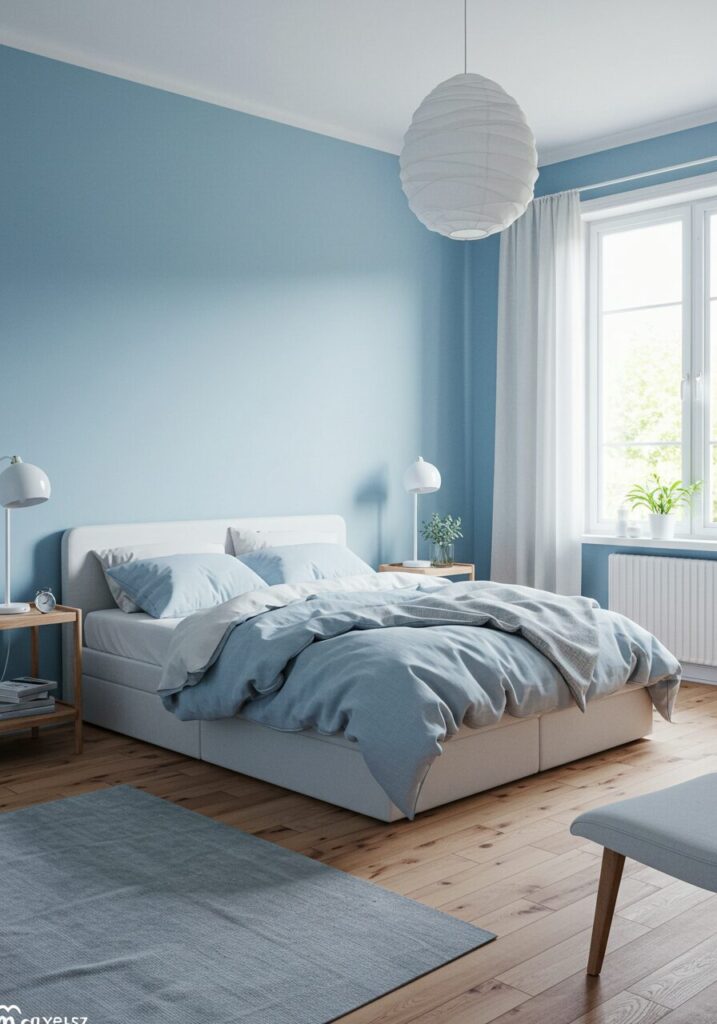
Pale blue walls evoke the calming qualities of Scandinavian skies and seas. This gentle color creates a tranquil atmosphere while maintaining the clean aesthetic of Nordic design.
The soft blue tone promotes relaxation and pairs beautifully with white accents and natural wood. It’s fresh and airy without being cold or stark.
Soft blue is particularly effective in bedrooms that face south, as it helps cool the space visually while maintaining brightness.
11. Warm Beige Scandinavian Comfort

Rich beige walls create a warm, embracing atmosphere in Scandinavian bedrooms. This neutral tone adds sophistication while maintaining the cozy qualities essential to Nordic design.
Beige works beautifully with both warm and cool wood tones, making it incredibly versatile. It’s timeless and creates a foundation that works with changing decor.
Beige is perfect for creating a hotel-like luxury feel at home, especially when paired with high-quality linens and minimal decor.
12. Muted Olive Green Scandinavian Nature

Subtle olive green walls bring the calming essence of nature indoors. This earthy tone creates a grounding atmosphere while maintaining Scandinavian simplicity.
The muted green pairs beautifully with natural wood and creates a sophisticated, mature bedroom. It’s calming without being too bold or overwhelming.
Olive green is particularly effective in urban bedrooms, as it brings a sense of nature to city living spaces.
13. Soft Gray Scandinavian Sophistication
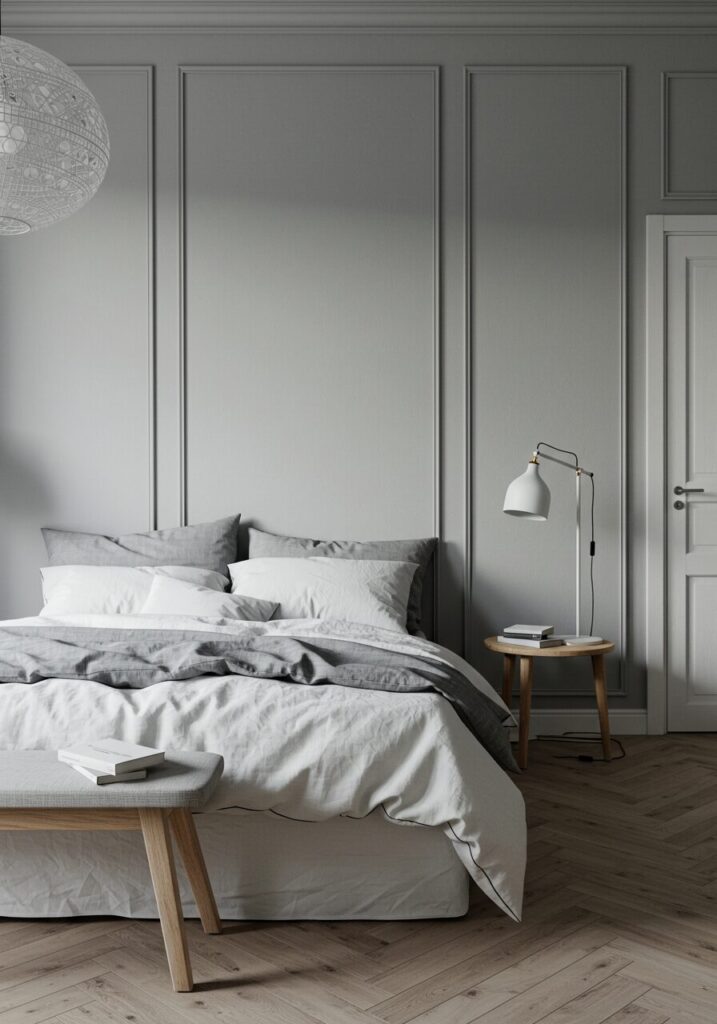
Gentle gray walls create a sophisticated, timeless bedroom that works with any decor. This versatile neutral provides the perfect backdrop for Scandinavian minimalism.
Gray is incredibly calming and works beautifully with white linens and natural wood furniture. It’s modern and classic simultaneously, never going out of style.
Gray is the ultimate chameleon color—it adapts to different lighting conditions and seasons, making it perfect for year-round comfort.
14. Warm Mushroom Scandinavian Earthiness
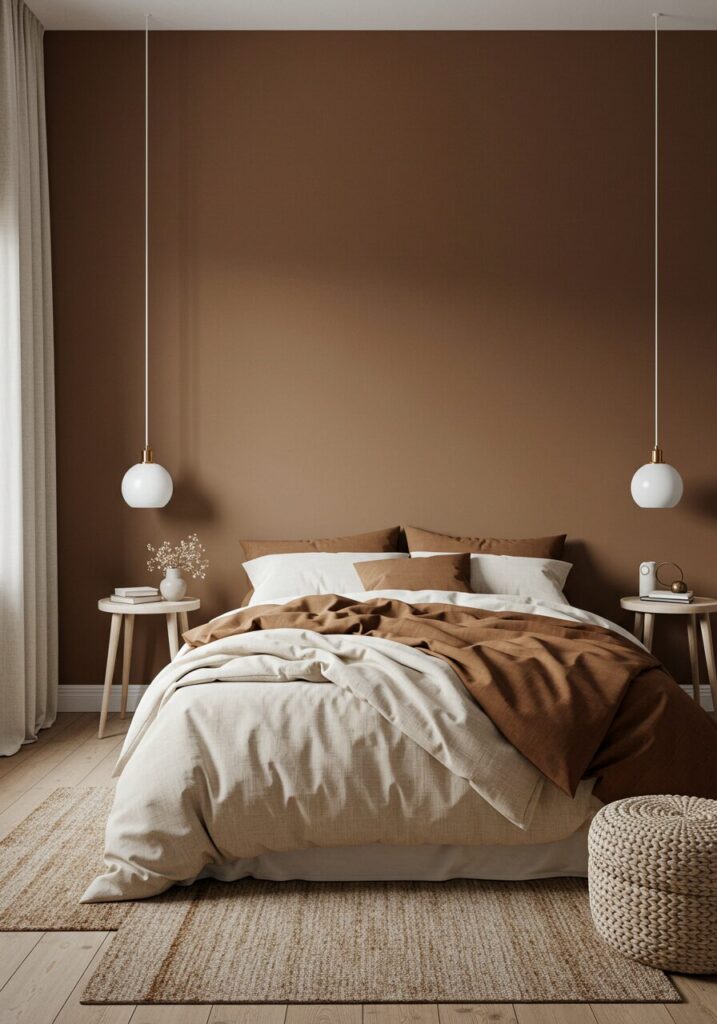
Earthy mushroom-colored walls create a grounding, natural atmosphere in Scandinavian bedrooms. This warm neutral adds depth while maintaining the clean aesthetic of Nordic design.
The organic tone works beautifully with natural materials and creates a cozy, cave-like feeling. It’s sophisticated and calming, perfect for creating a restful sanctuary.
Mushroom is particularly effective in bedrooms with limited natural light, as it adds warmth without making the space feel smaller.
15. Soft Peach Scandinavian Warmth
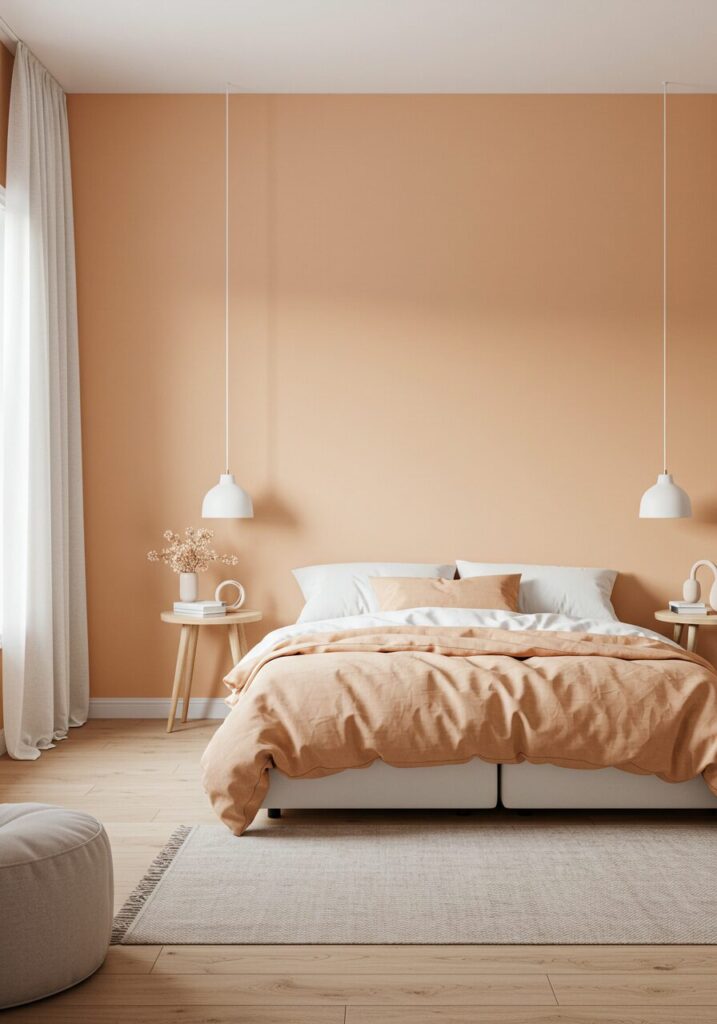
Gentle peach walls bring warmth and optimism to Scandinavian bedrooms. This soft, fruit-inspired color creates a cheerful yet calming atmosphere.
The warm tone complements natural wood beautifully and works well with white accents. It’s sophisticated enough for adults while maintaining a fresh, youthful energy.
Peach is particularly effective in bedrooms that face north, as it adds warmth and brightness to cooler natural light.
16. Muted Teal Scandinavian Serenity

Soft teal walls create a spa-like atmosphere in Scandinavian bedrooms. This blue-green hue combines the calming qualities of both colors while maintaining Nordic simplicity.
The sophisticated color works beautifully with white linens and natural wood furniture. It’s fresh and modern while promoting relaxation and tranquility.
Teal is incredibly versatile and works well with both warm and cool lighting, making it perfect for bedrooms used at different times of day.
17. Warm Taupe Scandinavian Elegance
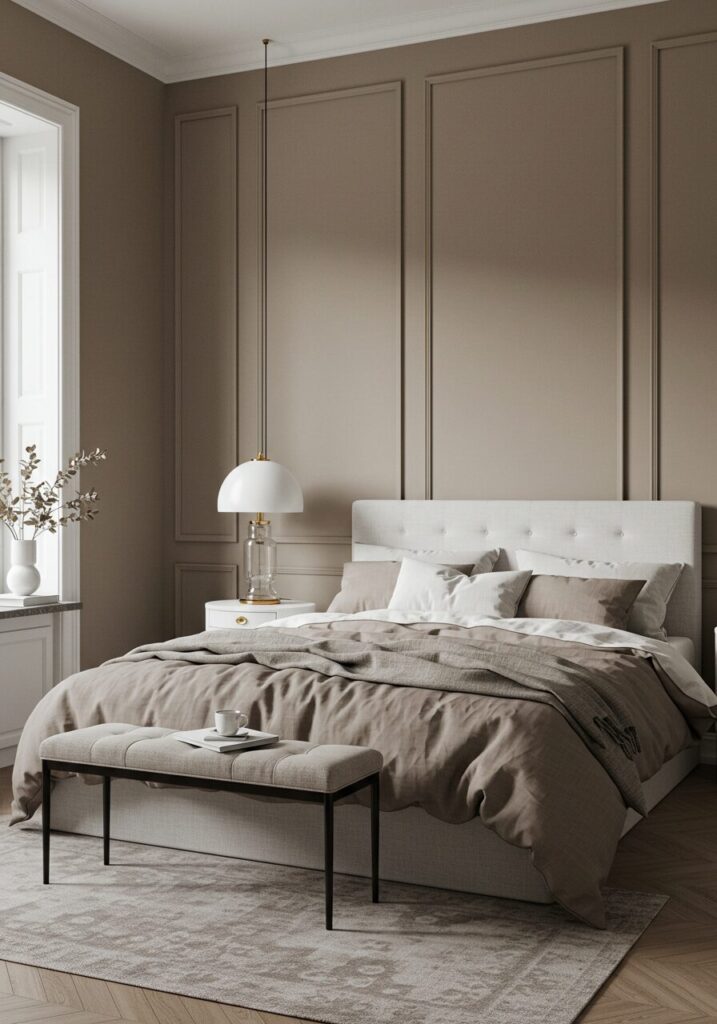
Rich taupe walls create an elegant, sophisticated bedroom that feels both modern and timeless. This warm neutral adds depth while maintaining Scandinavian minimalism.
Taupe works beautifully with both warm and cool accents, making it incredibly versatile. It’s sophisticated and calming, perfect for creating a luxury hotel feel at home.
Taupe is particularly effective in master bedrooms, as it creates a mature, sophisticated atmosphere that works well with quality linens and minimal furniture.
18. Soft Blush Scandinavian Romance
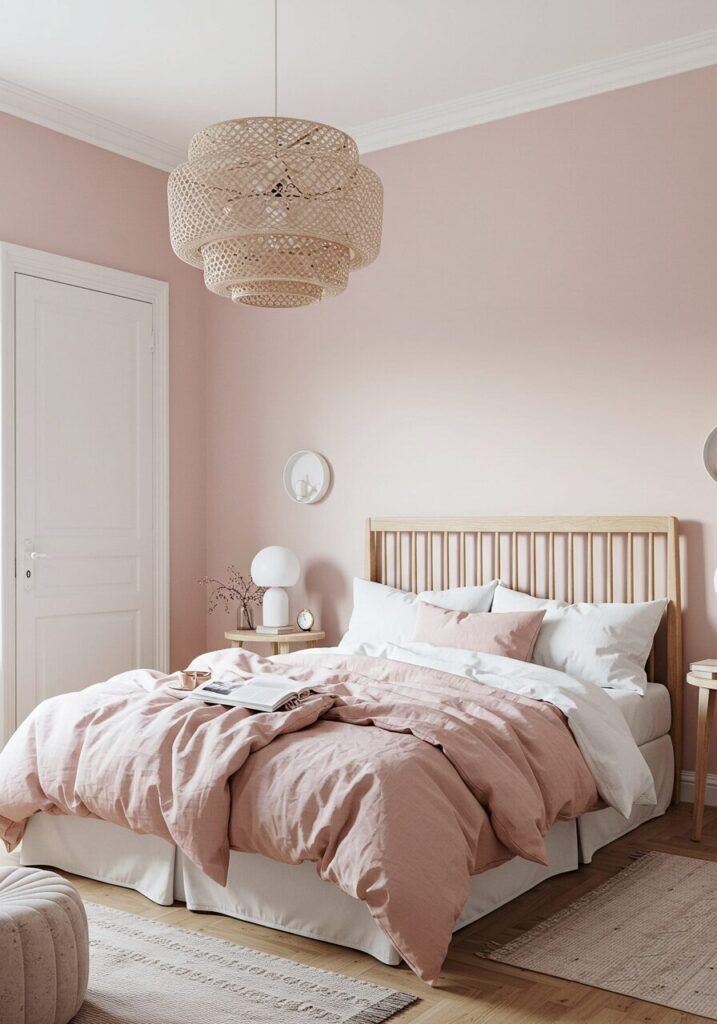
Gentle blush walls create a romantic, feminine atmosphere while maintaining Scandinavian sophistication. This soft pink hue adds warmth and personality to minimalist bedrooms.
The subtle color works beautifully with white linens and natural wood furniture. It’s mature and sophisticated, perfect for creating a romantic sanctuary.
Blush is incredibly flattering in bedroom lighting, creating a warm glow that makes everyone look their best in the morning.
